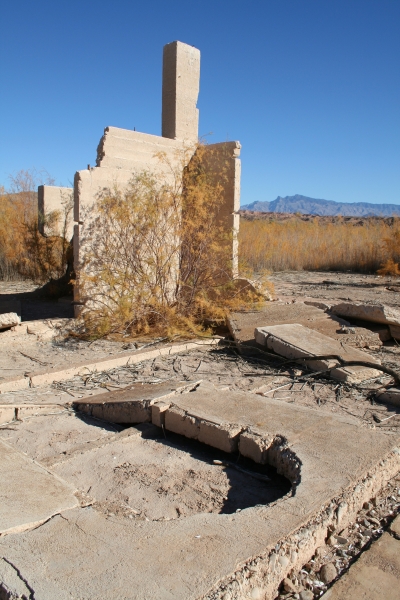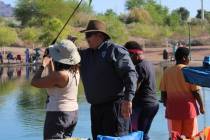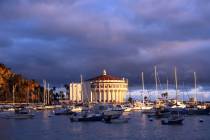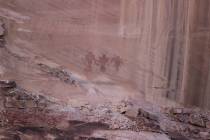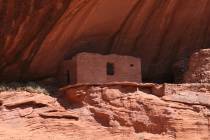St. Thomas, Nevada’s own Atlantis, revealed by Lake Mead’s low water level
For more than 60 years, the town of St. Thomas was a legend — Nevada's Atlantis, lying deep under the surface of Lake Mead. But after drought lowered the waters in 2002 and uncovered the old settlement, it has become an interesting and educational destination, with the bonus of a scenic drive to get there and back.
The town is accessible all year but these cooler months are a better time to visit, for the trail head to the town itself lies at 1,227 feet, and descends from there, so it can get plenty hot in summer. That said, in cooler weather the trail is an easy one, a loop of 2½ miles.
Now lying in Lake Mead National Recreation Area, it can be approached through the recreation area's Northshore Road or the drive through Valley of Fire State Park. Both are famously scenic routes, and it's logical to enjoy one on the way there and the other coming back.
This town was occupied from 1865 until 1938 when Lake Mead, gradually forming behind the newly built Boulder Dam (now Hoover Dam), rose high enough to flood the town. It was no surprise; construction on the dam had been planned for years and began in earnest in 1931, so townspeople were given evacuation notices before the water started rising.
Most of the residents relocated in a timely fashion. But one man, Hugh Lord, held out so long he had to depart St. Thomas by boat. The community cemetery was moved to nearby Overton, where it can be seen near the famous Lost City Museum. Many of the residents also settled in Overton, and continued to visit St. Thomas whenever circumstances allowed.
St. Thomas has emerged five times since 1938, during periods of low water, but most of the reappearances were brief. All those years underwater took their toll, so the main remnants of buildings, still visible today, are the parts made of concrete. Besides building foundations you also will find many round and square hollowed cement structures. These were cisterns, the common means of storing water for household use, back in the day.
The Park Service asks that you not climb or sit on any of the remaining walls; they're more fragile than one might imagine. You'll also notice, perhaps, artifacts such as broken bottles or iron implements. Federal law, however, requires that you leave items where you see them, to enhance the experience for those who visit later. Ubiquitous clam shells are not exactly artifacts, but a reminder of how long the town remained underwater.
Near the confluence of the Muddy and Virgin rivers, St. Thomas was founded by Mormon pioneers, who named it for one of the group's leaders, Thomas Sassen Smith. The settlers planned to raise cotton and mine, but cotton didn't grow as well as the pioneers had hoped. Furthermore, settlers had believed they were in Utah until an 1870 survey showed St. Thomas was in Nevada. Nevada officials demanded not only current Nevada taxes, but three years' arrears. Residents refused to pay, abandoned St. Thomas and returned to Utah. The town briefly was inhabited mostly by squatters and outlaws looking for a remote hiding place, an inherently transient bunch.
But St. Thomas' location made it too valuable to remain abandoned, so it was resettled in the 1880s. The former Old Spanish Trail, by this time commonly called the Mormon Road, was Southern Utah's main link to the West Coast, and St. Thomas stood on that wagon road, at one of the few points in the Mojave Desert providing adequate water and forage for oxen and mules.
When the age of the horseless carriage dawned, much of that route became part of the Arrowhead Trail, the first all-weather road between Los Angeles and Salt Lake City. St. Thomas had a hotel and several service stations and garages, and motorist guidebooks pointed out that the mechanics in those garages seemed to know what they were doing.
It also had a post office, school, stores and a church. The village population was probably never more than 500, but there were more at surrounding farms and mines.
The trail head is on a bluff overlooking the Overton Arm of Lake Mead. From here you won't be able to see the remains but you will be able to see a faint ribbon of green vegetation on the banks of the Muddy River. The Muddy here is making its final journey from Moapa Valley, lying to the north, down to Lake Mead. If you look a bit more to your right, or southeast, you can also see a larger tributary, the Virgin River, which flows from Utah.
St. Thomas is a day-use area only. Don't hike the trail if it has rained recently or rain threatens, as it becomes extremely muddy. The gravel access road is suitable for most vehicles except those that are low slung.
— Many of Deborah Wall's columns have been compiled in the book "Base Camp Las Vegas, Hiking the Southwestern States." She also is the author of "Great Hikes, a Cerca Country Guide" and co-author of the newly released "Access For All, Seeing the Southwest With Limited Mobility." Wall can be reached at Deborabus@aol.com.

